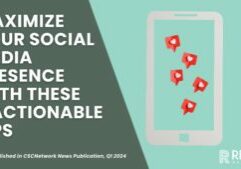Think Like a Customer In All Content Marketing
Whether you're selling a product, a service, or yourself, thinking like a customer is the key to making long-lasting connections.
When was the last time you enjoyed hearing someone spout off all of the things that make them amazing without any concern for the people around them– never? Empathy is crucial to building genuine connections.
There is a little give and take in successful and long-lasting relationships. The same rule applies to businesses and the people they serve.
Start Thinking About Your Customers With The Future in Mind
The world is becoming ever more connected as each day passes. The internet has provided us with the benefit of getting things faster than we could ever imagine. Instantly talk to your pen pal that lives on the other side of the globe or get that new TV you’ve been wanting - the day after you order it.
We’ve become used to getting what we want with the push of a fingertip. However, businesses thrive by creating lifelong relationships because finding a new customer is significantly more expensive than keeping the ones you already have.
You can achieve long-lasting relationships by using Duct Tape Marketing’s thought process:
“The very first thing you should do when thinking about bringing a product or service to market is to think about what you want the customer to be thinking and feeling about your product or service 180 days or so after they made the purchase and work backwards toward the point where they become interested in making a purchase.”
As a result, your messaging will include strategies to keep customers engaged and at the front of your mind through the entire purchasing process. Thinking like a customer in this way makes you get creative about how to make one-time purchasers more likely to buy again.
Make Sure Customers Aren’t Getting Lost in The Consumer Life Cycle
Seamless means having the same experience from start to finish. Smart Insights reports that “every touch point with the customer should really tell the same story and be consistent in the message. The outcome is loyalty where they seek to purchase again and/or refer. As your customers go through the purchase funnel, and the post-purchase cycle, they should have a consistent experience.”
For example, a discount clothing company could have amazing branding, a user-friendly website, and stylish clothes for sale. At the same time, a customer might make it to the checkout only to find that the clothing is the same price as the name brands and the shipping costs will make it even more expensive.
The goal is to have a consistent user experience in all forms from start to finish. Getting into the mindset of a customer can help you find any roadblocks along the way. Getting rid of these inconsistencies will help synchronize the consumer lifecycle and keep customers around longer.
Are Your Landing Pages Designed With The Customer in Mind?
You only get to make one first impression. Not to mention, the average time spent on a website is only 45 to 54 seconds. This means that half of all users are spending even less time than this on the websites they visit. Why is this?
Chroma Studios reports that on average, over 60% of users are going to hit the back button in their browser before there is any chance to understand your product or service; leaving just 40% who may stick around for a few seconds and check out another page or two on your site.”
There are many reasons why a user might leave a site rapidly, but for the moment we want to focus on capitalizing on the users that are sticking around. Each landing page on your website should have a very clear goal that is immediately noticeable. Users clicked on a link for a reason and they expect to reach the destination they have pictured in their mind.
Therefore, marketers should be entering the mind of their customers to craft landing pages that get to the point and are user friendly.
Not sure how to craft your landing pages to reflect what your customers are looking for? Talk to our team of experts at RED66 to help you reach your goals.
Don’t Get Lost in the Data
Tracking and data collection allow marketers to make informed decisions; however, data can often be misinterpreted and lead to a story that does not reflect the truth. It’s important to use data as a tool, but the end product should be crafted for your customer.
It’s easy to throw out numbers and make a case based on data. At the same time, you lose the connection to the customer and the personal touch when you take this approach. Thinking like your customers will always result in accurate and meaningful messaging.
Then you can support your communication with all the research and data that offers reassurance. Thinking about your customers as more than just a number on a spreadsheet will make you actually think like one.
Consumer Experience Management Starts with Corporate Culture
In Insight’s University’s words, customer experience management (CEM) goes “beyond service quality.” It’s all about creating a corporate culture focused on understanding and maintaining consumer relationships. That way, you can influence their perceptions, increase their loyalty, and thus earn a larger ROI.
Companies need core competencies that set them apart from their competitors. Knowing your audience and their habits, wants, and needs can offer valuable insights on positioning. Once you understand who you’re targeting and how you’re going to communicate with them, then a buyer persona can be created.
This persona will serve as a baseline for CEM. Here is an example of a buyer persona:

Your company's buyer persona will act as a guidepost for all decision-making. It can even be hung up in the office as a reminder to think; does this make sense for Sally?
The more specific you can get when creating your buyer persona, the better. It will only help narrow in on how to think like your customers.
Stay Consistent in Omnichannel Marketing
New social media channels are being released every day. Staple social media channels are holding their ground and some social media channels are being lost to the past – sorry, Myspace. Each has its own audience and it’s important to change your messaging to reflect this.
Nevertheless, the core message of your brand should remain consistent across all channels. Don’t fall into the trap of hopping on a hot topic if it doesn’t align with your communication standards.
One post has the potential to change many perceptions about what your company stands for. So be creative and bold, but always take a moment to think like your customers before you hit send.
Need help thinking like a customer in all content marketing? Reach out today and let our experienced team help you reach your goals.










